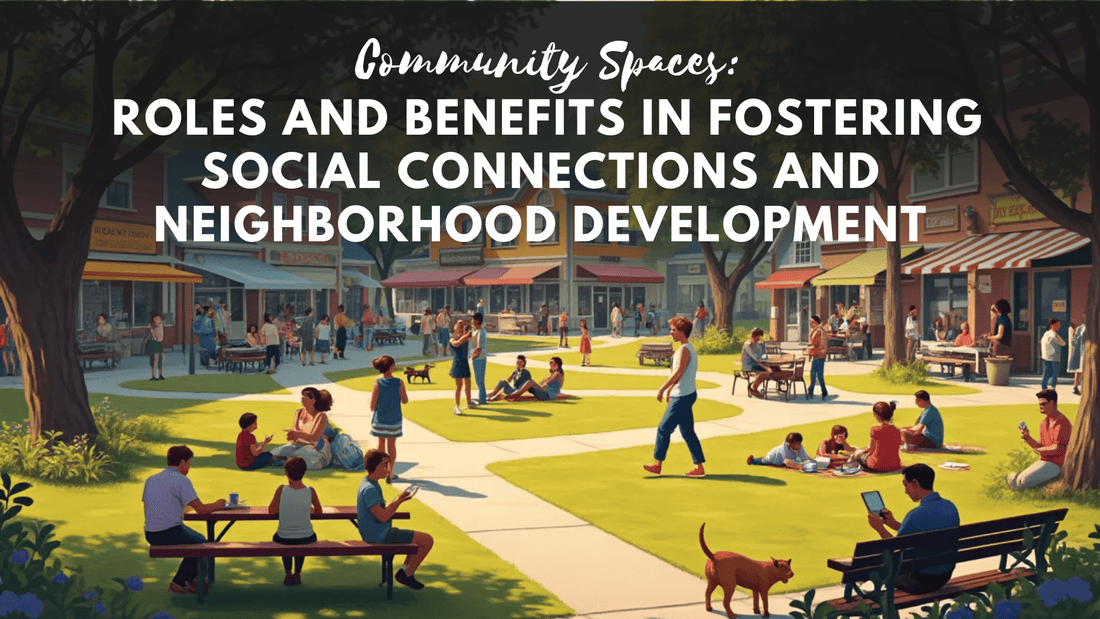
Community Spaces: Roles and Benefits in Fostering Social Connections and Neighborhood Development
Share
March 16, 2025
Community spaces serve as vital hubs for connection, growth, and wellbeing in our neighborhoods. They provide places where people can gather, learn, and engage in activities that build stronger social bonds. Community centers, parks, and public areas create foundations for healthy communities by promoting physical activity, reducing stress, and offering equal access to resources for everyone.
These shared spaces play multiple important roles in our daily lives. They act as anchors for downtowns and communities, establishing focal points that help define a neighborhood's identity. Beyond just providing a place to meet, community spaces encourage healthy behaviors and offer opportunities for people to build confidence and develop friendships through shared activities.
In today's increasingly digital world, the physical connections fostered by community spaces are more important than ever. These areas create environments where you can step away from screens and engage with others face-to-face. Well-designed community spaces reduce stress and anxiety while providing access to green spaces that improve mental health.
Key Takeaways
- Community spaces strengthen social connections and provide equal access to resources that improve your quality of life.
- Well-designed public areas promote physical and mental health by offering places for activity, stress reduction, and social interaction.
- These shared environments serve as neighborhood anchors that help define community identity and support healthy growth.
Defining Community Spaces
Community spaces are physical locations where people gather for social, educational, or recreational activities. These spaces serve as vital hubs for connection and often reflect the unique character and needs of their surrounding population.
Types of Community Spaces
Community spaces come in many forms, each serving different functions for residents. Public parks and plazas offer outdoor gathering spots for relaxation and recreation. These areas often include benches, playgrounds, and open green spaces where you can enjoy nature within urban environments.
Libraries and community centers provide indoor spaces for learning, meetings, and organized activities. These facilities typically offer programs for various age groups and interests, from children's storytimes to senior fitness classes.
Arts and culture facilities create spaces for creative expression and appreciation. Theaters, galleries, and performance venues bring communities together through shared cultural experiences.
Nonprofit centers foster collaboration among organizations serving similar populations. These shared spaces help create stability and affordability for groups working toward community improvement.
Historical Evolution
Community spaces have transformed significantly throughout human history. In ancient times, public forums and marketplaces served as centers for commerce, politics, and social interaction. These spaces were the heartbeat of early civilizations, where ideas and goods were exchanged freely.
During the Industrial Revolution, planned parks emerged as a response to overcrowded urban conditions. Designers like Frederick Law Olmsted created spaces where factory workers could escape city pollution and enjoy natural surroundings.
The 20th century saw the rise of purpose-built infrastructure designed to build social networks and provide equitable access to community resources. Libraries expanded their missions beyond book lending to become full-service community hubs.
Today's community spaces increasingly emphasize inclusivity and flexibility, adapting to diverse population needs and technological changes.
Roles in Community Spaces
Community spaces function effectively through the contributions of various individuals who take on specific roles. These roles create structure, promote engagement, and ensure spaces remain accessible and well-maintained for everyone's benefit.
Facilitators and Organizers
Facilitators and organizers serve as the backbone of community spaces, guiding activities and creating opportunities for connection. They develop programming that responds to community needs and interests.
Key Responsibilities:
- Planning and coordinating events and regular activities
- Managing space schedules and resource allocation
- Building relationships with community members
- Mediating conflicts and ensuring inclusive participation
Effective facilitators understand local dynamics and create environments where everyone feels welcome. They often serve as the bridge between different community groups.
Your community space likely has both formal and informal facilitators. Formal facilitators might include paid staff, while informal ones emerge naturally through regular participation and leadership qualities.
Participants and Users
Participants transform physical spaces into vibrant community places through their presence and engagement. Their diverse perspectives and contributions create the community's culture.
Types of Participants:
- Regular attendees who form the core community
- Occasional visitors exploring available resources
- Special interest groups using specialized facilities
- Event attendees participating in organized activities
Your participation patterns may vary based on personal interests and needs. Some community members visit daily, while others connect during specific programs or seasonal events.
Active participants often transition into volunteer roles or advisory positions. This natural progression strengthens community ownership and ensures spaces evolve to meet changing needs.
Support Services
Support services provide essential infrastructure that enables community spaces to function smoothly and meet diverse needs. These services address practical requirements and enhance user experience.
Critical Support Functions:
- Administrative assistance for space management
- Technical support for equipment and digital resources
- Food and refreshment services during programs
- Childcare during adult-focused activities
- Transportation assistance for accessibility
You'll find that the most successful community spaces offer layered support systems. These systems remove barriers to participation for community members of all ages and abilities.
Support services often adapt based on community feedback. Regular surveys and suggestion systems help identify gaps and improve service quality.
Maintenance And Operations
Maintenance teams ensure public spaces remain functional, safe, and appealing. Their behind-the-scenes work creates environments where community activities can flourish.
Essential Maintenance Tasks:
- Regular cleaning and sanitation
- Repairs to equipment and facilities
- Landscaping and green space management
- Security monitoring and access control
- Utilities management and sustainability efforts
Your experience in community spaces depends heavily on these operational functions. Well-maintained spaces encourage more frequent use and positive social interactions.
Community members often supplement professional maintenance through volunteer cleanup days or "adopt-a-space" programs. This collaborative approach builds ownership while reducing operational costs.
Benefits of Community Spaces
Community spaces deliver multiple advantages that enhance quality of life for residents. These spaces foster connections between people, boost local economies, improve physical and mental health, and preserve cultural heritage.
Social Cohesion
Community spaces serve as vital meeting points where people from diverse backgrounds can interact. When you visit these spaces regularly, you build social networks with neighbors and develop a stronger sense of belonging.
Public squares, community centers, and shared gardens create opportunities for meaningful exchanges. These interactions help reduce isolation and loneliness, particularly important for elderly community members.
Community spaces also promote civic engagement by providing venues for local meetings, community organizing, and collaborative problem-solving. When you participate in these activities, you develop deeper connections to your neighborhood.
Well-designed community spaces can bridge social divides by creating neutral territory where different social groups naturally mix. This integration helps build trust and understanding across cultural, economic, and generational differences.
Economic Advantages
Community spaces can significantly boost local economies in multiple ways. They often serve as anchors for downtowns and neighborhoods, attracting visitors and encouraging extended stays in commercial areas.
When you invest in quality community spaces, property values typically increase in surrounding areas. Businesses near vibrant public spaces often see higher foot traffic and increased sales.
Economic Benefits of Community Spaces:
- Increased property values
- Higher foot traffic for nearby businesses
- Attraction of new businesses and residents
- Creation of jobs (maintenance, programming, administration)
- Reduced costs for social services through prevention
Community spaces like nonprofit centers foster collaboration and provide long-term affordability and stability for organizations serving the community. This infrastructure supports social enterprises and small businesses that might otherwise struggle with high commercial rents.
Health and Wellness
Access to community spaces significantly improves your physical and mental wellbeing. Green spaces encourage physical activity through walking, jogging, sports, and play, helping you maintain a healthy weight and cardiovascular health.
Community gardens provide opportunities for physical activity while increasing access to fresh, nutritious foods. Public spaces with adequate seating, shade, and pleasant surroundings invite you to spend time outdoors.
Outdoor activities in community spaces have been shown to boost brain function, build confidence and self-esteem, and reduce stress levels. Natural elements in these spaces can lower blood pressure and improve mood.
Social connections formed in community spaces combat isolation and depression. Accessible recreation facilities make it easier for you to maintain consistent physical activity, regardless of income level, promoting equity in health outcomes.
Cultural Impact
Community spaces play a crucial role in preserving and celebrating local culture. Art centers, museums, and performance venues showcase your community's unique creative expressions and maintain cultural traditions across generations.
These spaces provide platforms for local artists and performers to share their work. Public art installations in community spaces make art accessible to everyone, regardless of socioeconomic status.
Cultural festivals and events held in community spaces:
- Celebrate diverse heritages
- Educate community members about different traditions
- Create shared experiences that build community identity
- Support cultural tourism
Arts and culture facilities in your neighborhood provide stability for creative endeavors that might otherwise lack permanent homes. They serve as incubators for new cultural expressions while honoring established traditions.
When you participate in cultural activities in community spaces, you develop a stronger sense of place and connection to your community's history and identity.
Challenges and Solutions
Creating successful community spaces involves overcoming several key obstacles. With the right strategies, these challenges can be addressed to create inclusive, sustainable, and effective community environments.
Funding and Resource Allocation
Securing adequate funding remains one of the top challenges in community engagement. Community spaces often struggle with limited budgets and resources, affecting their ability to deliver quality services.
Key funding challenges:
- Initial development costs
- Ongoing maintenance expenses
- Staffing and program costs
- Utilities and operational expenses
To overcome these obstacles, you can explore diverse funding streams. Public-private partnerships offer a valuable solution by combining government support with private investment.
Grant applications from foundations and community development funds can provide project-specific funding. Consider implementing a tiered membership model where users contribute based on their ability to pay.
Regular community fundraising events not only generate income but also increase local ownership. Demonstrating social value and impact through data collection and reporting can help secure long-term investment from stakeholders.
Accessibility and Inclusion
Community spaces must serve everyone, regardless of age, ability, or background. Physical barriers like poor location, inadequate transportation, and lack of disability accommodations can limit participation.
Improving accessibility:
- Install ramps, elevators, and accessible bathrooms
- Provide clear signage with universal symbols
- Ensure adequate lighting and acoustics
- Offer flexible hours for different work schedules
Beyond physical access, cultural barriers need attention. Programs should reflect the diverse interests of the community. Multilingual materials and translation services help overcome language barriers.
Digital access is increasingly important. Offering free Wi-Fi and computer stations ensures that technology gaps don't exclude community members. Consider hosting digital literacy workshops to build skills and confidence.
Creating a welcoming atmosphere means training staff in cultural competence and inclusive practices. Regular community feedback sessions help identify and address accessibility gaps before they become barriers to participation.
Safety and Security
A sense of safety is fundamental for community space success. When people feel unsafe, they simply won't participate, regardless of how valuable the services might be.
Essential safety measures:
- Adequate lighting in all areas, especially entrances and walkways
- Clear sightlines without hidden corners or obstructed views
- Security personnel or volunteer monitoring during events
- Emergency response plans and regular safety drills
Community spaces in mixed-use developments should implement access control systems that balance security with convenience. Key card entry systems provide this balance while maintaining data on usage patterns.
Safety concerns extend to emotional and psychological safety too. Creating and enforcing clear codes of conduct helps establish behavioral expectations. Conflict resolution mechanisms should be in place to address issues when they arise.
Strategic amenity planning with defined activity zones helps manage different user groups and their needs. Consider how space design influences behavior and perception of safety. Open, well-lit spaces with natural surveillance tend to discourage problematic behaviors.
Future of Community Spaces
Community spaces are evolving rapidly to meet changing social needs, environmental challenges, and technological advancements. These transformations will reshape how people connect and interact within shared environments.
Technological Integration
Smart community centers are becoming reality with features like digital information kiosks and app-based room reservations. You'll find more spaces incorporating Wi-Fi connectivity and digital tools that enhance user experience and accessibility.
Virtual reality (VR) lounges will allow community members to experience educational programs together. These technologies won't replace physical gatherings but complement them.
Interactive displays will track community goals like volunteer hours or recycling milestones. This gamification approach encourages participation and builds community pride.
Remote participation options will become standard, ensuring those with mobility challenges or busy schedules can still engage. This hybrid approach makes community spaces more inclusive and adaptable to various needs.
Sustainable Practices
Future community spaces will incorporate green building techniques as standard practice. You'll see more communal gardens and outdoor areas designed to promote both environmental sustainability and social connection.
Energy-efficient features like solar panels, rainwater collection systems, and natural lighting will reduce operational costs. These savings can be redirected to community programming and services.
Community repair cafés where you can learn to fix items rather than replace them will become common. These spaces promote skill-sharing while reducing waste.
Edible landscapes surrounding community centers will provide fresh produce and educational opportunities. These multi-functional green spaces serve ecological, social, and educational purposes simultaneously.
Urban Planning Trends
City planners are increasingly designing neighborhoods around centralized community hubs that serve multiple functions. You'll notice more mixed-use developments integrating housing, retail, and community spaces.
The "15-minute city" concept places community spaces within walking distance of residences. This approach reduces traffic while increasing accessibility and spontaneous community interaction.
Flexible, multi-purpose spaces will adapt to changing community needs throughout the day. A single space might function as a senior center in the morning, after-school program in the afternoon, and adult education venue in the evening.
Pop-up community spaces in underutilized areas will test concepts before permanent investment. This strategy allows for community input and adjustments before major resources are committed.
Frequently Asked Questions
Community spaces serve essential roles in bringing people together, fostering connections, and improving quality of life. These spaces address common questions about design, purpose, and impact on the communities they serve.
What are the defining characteristics of successful community spaces?
Successful community spaces provide areas where people can connect and gather comfortably. They typically feature flexible layouts that accommodate various activities and group sizes.
Good community spaces reflect local identity and respond to specific community needs rather than following a one-size-fits-all approach.
They balance indoor and outdoor elements, incorporate natural lighting, and offer both active and quiet zones where people can work, socialize, relax, or play.
Accessibility, safety, and regular maintenance are fundamental characteristics that ensure these spaces remain welcoming to all community members.
How do public spaces contribute to civic engagement and community well-being?
Public spaces create neutral ground where diverse community members can interact, breaking down social barriers and building mutual understanding.
They provide venues for community meetings, public forums, and civic events that encourage participation in local governance and community decision-making.
These spaces often improve community, civic and personal health while amplifying voices of those who might otherwise go unheard.
Research shows that access to quality public spaces correlates with improved mental health outcomes and stronger social bonds between residents.
In what ways do community centers enhance neighborhood cohesion?
Community centers serve as hubs where neighbors can meet regularly, fostering relationships that might not develop otherwise. They provide neutral territory for diverse groups to interact.
These centers often host classes, workshops, and events that celebrate cultural diversity and local heritage, strengthening community identity.
Common lounge areas bring communities together by providing comfortable spaces for socializing or simply relaxing around others.
For new residents, community centers offer entry points into neighborhood networks, accelerating their integration into the existing community fabric.
What functions do community spaces serve in urban development?
Community spaces act as anchors in urban planning, creating focal points around which housing, businesses, and services can develop organically.
They provide crucial green space and recreational opportunities in dense urban environments where private outdoor space is limited.
In redevelopment projects, thoughtfully designed community spaces can help prevent displacement by preserving neighborhood character and creating gathering places that benefit existing residents.
These spaces often increase adjacent property values while providing public benefits that improve quality of life for all residents.
How are community spaces designed to be inclusive and accessible to diverse populations?
Inclusive community spaces incorporate universal design principles that accommodate people of all abilities, with features like ramps, elevators, and accessible restrooms.
Multilingual signage, culturally relevant programming, and diverse staff help ensure that community spaces welcome people from various cultural backgrounds.
Thoughtful scheduling of activities and varying fee structures (including free options) make these spaces accessible to people with different work schedules and income levels.
The best community spaces actively seek input from diverse community members during both planning and operational phases to address barriers to participation.
What are the economic and social benefits of investing in community spaces?
Investment in community spaces often stimulates local economic activity by increasing foot traffic to nearby businesses and creating jobs through programming and maintenance.
These spaces can reduce healthcare costs by providing venues for physical activity, social connection, and stress reduction—all factors that contribute to better health outcomes.
Community spaces where people learn new things and share interests build social capital that strengthens neighborhood resilience during crises.
For children and youth, access to community spaces correlates with better educational outcomes and reduced involvement in risky behaviors, creating long-term social benefits.


